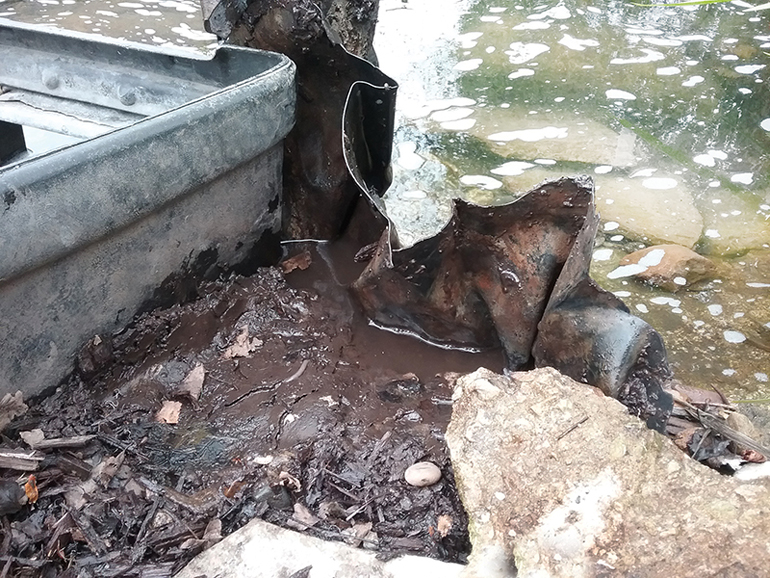
The leakers represent a serious issue that must be dealt with. They are eroding the chances of us ever being successful.
Thankfully, I’m not talking about politics. No, the “leakers” in our industry like to turn dirt into mud. Sometimes they cause certain plants to grow like crazy while the rest of the landscape wilts. They almost always result in puddles of standing water on the wrong side of a pond liner.
Leaks can be frustrating, elusive or incredibly annoying for a homeowner; in extreme cases, they can lead to serious problems that could result in harm to fish and damage to costly pumps and other equipment.
The Nature of a Leaker
Leaks happen for a number of different reasons. A comprehensive article on all possible leaks and their solutions would fill an entire book. The best builders are not immune to accidents, equipment failure or wildlife damage. Even a neglected or dirty filter pad can cause water to be forced around it and over the edge of a filter box.
Water is, by nature, a dynamic and unpredictable force. Attempts to contain and shape it by less experienced contractors — including enthusiastic homeowners — often lead to it escaping the confines of its intended area. We at Specialty Water Gardens have learned a lot by observing and correcting the mistakes of others, but I personally have learned even more from the mistakes I’ve made myself. The water features we build now are a lot more reliable than some of our earlier attempts. Through experience and education, we’ve also learned techniques that will prevent most common leaks from happening. Some ponds have a propensity to leak anyway, and frequently, we are called upon to find and fix an elusive leak in a pond that isn’t one of ours.
Part of being a water garden professional is identifying and repairing leaks in a timely, competent manner. The confidence that the successful repair of a leak can instill in a new client often leads to additional sales like other repair services, new products or ideally a full rebuild of an old or inefficient water garden.
Landscapers and homeowners of all skill levels may attempt to build a water feature at some point. Often times, the job is respectable; but sometimes, the results are less than ideal. But when a pond owner develops a leak and needs assistance, they usually seek out the help of a pond professional. Here’s the story of a recent repair project that exhibited many different, but common leaks, and how we found and fixed them.
A Pond Gone Wrong
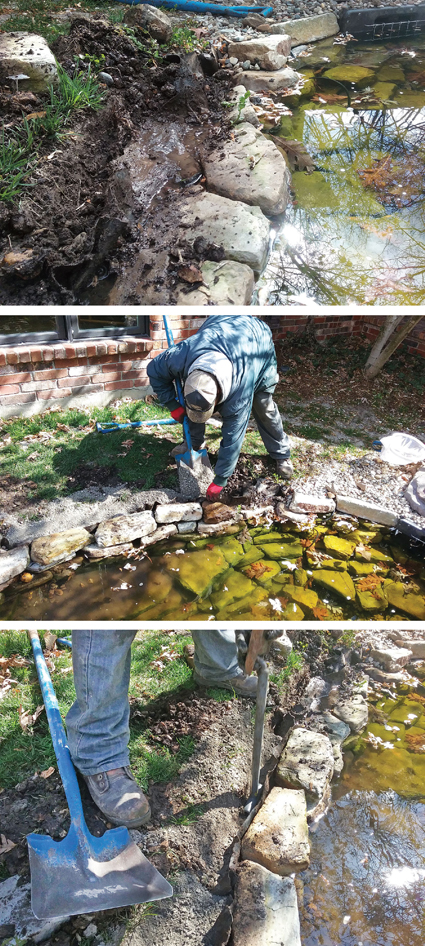
This particular pond was already familiar to us. It was originally homeowner-built, and several years before, we had actually installed a new skimmer and biofilter. It functioned well enough, and although it required an annual cleanout, problems were minimal. We were able to provide the owner with some products and services to keep it reasonably healthy.
This time, it had several apparent problems, and after an initial assessment, a few leaks were showing up in areas where we had seen leakage before. None of the leaks appeared to be fatal, but it would be a long process to track down all the issues and repair them.
Unfortunately, the liner was starting to degrade, and the homeowner’s dog had caused some punctures. The owners, Ray and Sue, were interested in replacing the liner and changing up the look of it, so early last year, I met with him to discuss a rebuild. We talked about making it quite a bit bigger and changing the stone from small, flat-stacked stones to larger, weathered boulders. We also wanted to improve the filtration and pumps, and we considered building an Asian-style bridge that would span the pond and lead to the front door. My estimate was not unreasonable for the size of the project, but ultimately, he decided to go smaller and hired someone else to rebuild the pond.
The story is probably familiar to many of you — the yard guy knew a guy who knew another guy, and collectively they all knew how to do “that kind of stuff.” The contractor who won the job said that he could put in a new liner and make it a little bigger, but to my surprise, he wouldn’t need to bring in any additional stone. He also vowed to keep the same pump and filters, but just move them around. So, his price was less than a quarter of my price for the more extensive rebuild.
It’s not Ray’s fault, of course. It seemed like a good deal at the time, but unfortunately, he was left with a leaker. After some discussion, Ray decided he still didn’t want to expand and change the pond too much, especially after having just spent a chunk of money to have it “fixed.” We agreed to track down the issues one at a time and repair them to the best of our ability.
Some of the leaks in the pond were readily apparent, but in order to know exactly what we were dealing with, we began a process of elimination to figure out where in the system the leaks were occurring. This pond had the original skimmer, pump and biofilter I had installed a few years earlier. These drove the main waterfall, and a new, box-store-brand pump in the bottom of the pond circulated to a second, smaller waterfall. Ray told us that even when the pumps were off, the water would drop quickly at first and then slow down to a steady leak. When he turned the pump on, the pond would go from full to the bottom of the skimmer opening within one day. I knew at this point that we would need to look for leaks in both the dynamic and static parts of the system.
Static Leaks
A hole in the liner was a possibility; we would just need to find it. We brought in an aerator for the fish, filled the pond to its full mark and left the pump off. We hoped this would allow the pond to leak down to the spot where the liner was damaged and stop there.
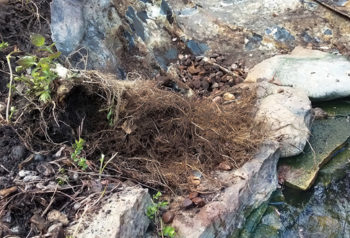
This method for finding the static pond leaks is not always reliable, because our Midwest clay soil tends to drain poorly and holds too much water. However, Ray had originally installed a drainpipe under the pond for groundwater evacuation, and it still worked. We saw the water coming out the other end. The pond dropped rapidly, and we identified several spots along the pond’s top edge where the water was going over.
After the water level continued to steadily drop for a few days, it stabilized at a spot right along the bottom of the skimmer faceplate. This is a commonly leaky area among older skimmers when the silicone breaks down or the hardware corrodes, but this skimmer used an all-compression seal. Moving some stones and feeling around the faceplate revealed a spot where a small fold in the liner prevented the faceplate from correctly sealing against the liner. The skimmer had also been set too low and was crooked.
We dug up the skimmer and realigned it. We also installed an overflow pipe directly through the liner using a bulkhead fitting. This would give us a point of reference to ensure that the liner was brought up higher than the edge of the pond. Thankfully, even though the pond edges were low and leaking, they hadn’t been trimmed too close, and we were able to find enough liner to pull them up above the overflow level and reinforce them with base gravel.
After the pond was cleaned and refilled, the water level thankfully remained stable, so we were quite confident that the pond itself would now hold water exactly as it was intended to do.
Dynamic Leaks
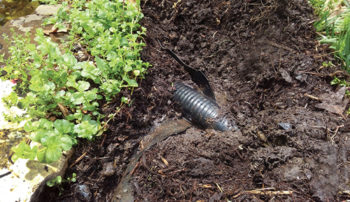
As we moved on to the dynamic part of the system, we had previously observed through our inspections that the waterfall lip on the skimmer had been improperly installed. We had also noted some wet areas along the each side of the stream and a Japanese maple next to the falls that was abnormally lush and full. A second Japanese maple planted just a few feet away was noticeably thinner. It’d been a dry spring, so this very well fed tree was highly suspicious.
We pulled the stones away from the biofilter to get a better idea of the situation and discovered that not only had the lip been installed incorrectly, but the liner underneath also had several small holes in it. The thriving Japanese maple was taking full advantage of these “watering holes.” We showed this to Ray, and I suggested that it would be best to replace the whole section of liner under the falls and bring in some new boulders to build the waterfall again. When Ray agreed to this plan, I was quite pleased, as it meant that I could make things look a little more natural and appealing.
After cutting out and disposing of the damaged liner, we seamed on a new piece and attached it to the biofilter in a proper manner. Some small boulders were brought in, and the waterfall was rebuilt.
Felonious Foam
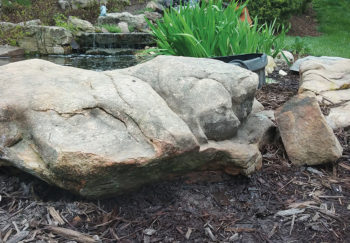
That left only one section of the feature that hadn’t been addressed, the second, smaller waterfall that was fed by a submersible pump in the bottom of the pond. This side of the stream also showed a spot where the soil was damp, and another leak was suspected. Digging up the wet area revealed that the builder had crossed over the top of the liner from the outside to go up to the falls with the return pipe, and he had pushed down the liner around it. This folded-down area was below the water level of the stream when it was running. He had then attempted to seal up the area between the pipe and liner with black waterfall foam.
Black foam is handy stuff, but it’s porous and will wick water through it. Black foam should never be used to prevent water from leaking or going over an edge. Only pond liner that is brought completely above the water level and well reinforced to prevent settling will reliably hold the water.
This being (hopefully) the last issue to address, the homeowners gave me permission to go ahead and fix it the way I wanted to. So, we set out to rebuild the second waterfall to match the main one. We cut the pipe off where it crossed over the liner and ran a new piece up the outside. This allowed us to raise the liner edge and contain all the water within the stream. The installation of a bulkhead fitting then allowed us to safely penetrate the liner at the top of the waterfall area and install a compact waterfall box. The finished stonework looks natural and so much better.
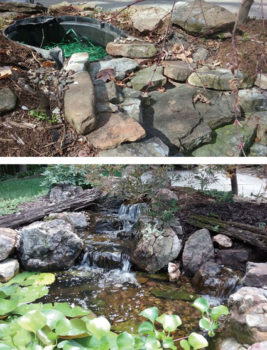
The repair is complete, and the pond is no longer a leaker. Ray and Sue can leave for more than a day without worrying about burning up a pump or leaving the fish high and dry. I would’ve liked to have done the original rebuild, but I know that when they are ready, we will have fully earned their trust. We will be ready to deliver a new pond that they can count on to function properly and last for many years.
We can’t prevent every possible leak from happening, but we can build in a manner that ensures longevity and reliability. A quality builder knows how to go into a bad situation and do what it takes to fix a troublesome leaker. This is what sets a dedicated water garden professional apart from that yard guy who knows another guy, who…you know the drill.



My pond is a frog pond and I am sure it is leaking. This started about maybe 18/20 months ago, started to clear it out last year but kept finding live tadpoles in the mud so put them all back but still have the leak 1. How do I find out where the leak is and 2. What would be the cost of a diagnosis?
Answer from the author, Josiah Crousure:
Water loss is best found through observation and a process of elimination in order to first identify the area where it is leaking, then making a plan to repair it. You will try to isolate different areas of the pond while observing the water level to see if it still loses any.
I usually start with: Does the pond lose water only when running a pump, or does it lose water when just sitting still. Most of the time, the loss is in the moving water (dynamic) part of the pond. This could be the plumbing, waterfall or stream edge, or filter through which the water passes.
If the loss is in the pond itself, then often, you can observe the drop and look around at the level where it stabilizes. Liner or plastic ponds can often be patched, earthen ponds are more difficult.
Ponds can be built in many different ways and the methods for finding water loss will vary with them. Without knowing your exact setup, i would have a hard time advising you what to do first.
A pond professional with experience finding leaks can help. Water loss can often apparent if someone knows where to look, but can also be difficult and time consuming to find a persistent leak. Someone who knows what to do first and is familiar with the proper methods for repair will save time and money in the long run.
We charge $125/hr. plus materials for on site leak detection and repair. I would recommend you try and find a local water feature specialist. If none are available, some contractors including myself, offer remote consultation for a fee. Thank you for your question.